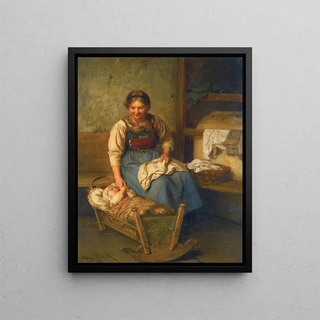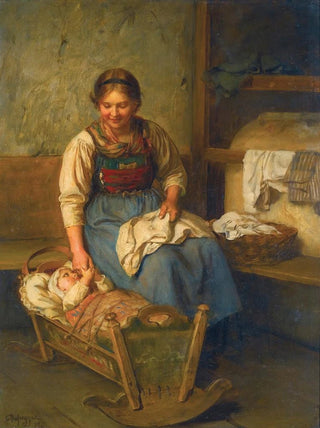Art print | Pride of Mothers - Franz von Defregger


View from behind

Frame (optional)
Pride of Mothers - Franz von Defregger – Captivating Introduction
In the rich and complex universe of art, certain works transcend time and space, capturing the very essence of humanity. "Pride of Mothers" by Franz von Defregger is a perfect example. This painting, which evokes the tenderness and strength of mothers, immerses us in a world where emotions are palpable. The scene, both intimate and universal, resonates with anyone who has experienced a mother's unconditional love. Through this art print, we are invited to explore the nuances of this iconic work, reflecting a particular era and artistic sensibility.
Style and uniqueness of the work
Franz von Defregger's style is characterized by striking realism, which manages to capture not only the physical traits of his subjects but also their deep emotions. In "Pride of Mothers," every detail, from facial expressions to delicate gestures, demonstrates technical mastery and rare artistic sensitivity. The light, skillfully orchestrated, creates a warm atmosphere, enveloping the characters in an aura of softness. The colors, both vivid and harmonious, reinforce the idea of joy and pride, inviting the viewer to feel the intensity of the moment. The work also stands out for its balanced composition, guiding the eye and emphasizing the interaction between the figures. This painting, far from being a simple representation, becomes a true celebration of motherhood, a tribute to the strength and beauty of family bonds.
The artist and his influence
Franz von Defregger, born in 1851, is an emblematic figure of the Austrian artistic movement of the 19th century. His career, marked by a constant search for authenticity and expression, led him to explore various themes, but it was everyday life and popular traditions that particularly inspired him. Defregger was able to capture the soul of his era, offering a tender and respectful look at ordinary people. His influence extends beyond his works, touching many contemporary and future artists who sought to express the beauty of simple moments and deep emotions. By incorporating elements of

Matte finish

View from behind

Frame (optional)
Pride of Mothers - Franz von Defregger – Captivating Introduction
In the rich and complex universe of art, certain works transcend time and space, capturing the very essence of humanity. "Pride of Mothers" by Franz von Defregger is a perfect example. This painting, which evokes the tenderness and strength of mothers, immerses us in a world where emotions are palpable. The scene, both intimate and universal, resonates with anyone who has experienced a mother's unconditional love. Through this art print, we are invited to explore the nuances of this iconic work, reflecting a particular era and artistic sensibility.
Style and uniqueness of the work
Franz von Defregger's style is characterized by striking realism, which manages to capture not only the physical traits of his subjects but also their deep emotions. In "Pride of Mothers," every detail, from facial expressions to delicate gestures, demonstrates technical mastery and rare artistic sensitivity. The light, skillfully orchestrated, creates a warm atmosphere, enveloping the characters in an aura of softness. The colors, both vivid and harmonious, reinforce the idea of joy and pride, inviting the viewer to feel the intensity of the moment. The work also stands out for its balanced composition, guiding the eye and emphasizing the interaction between the figures. This painting, far from being a simple representation, becomes a true celebration of motherhood, a tribute to the strength and beauty of family bonds.
The artist and his influence
Franz von Defregger, born in 1851, is an emblematic figure of the Austrian artistic movement of the 19th century. His career, marked by a constant search for authenticity and expression, led him to explore various themes, but it was everyday life and popular traditions that particularly inspired him. Defregger was able to capture the soul of his era, offering a tender and respectful look at ordinary people. His influence extends beyond his works, touching many contemporary and future artists who sought to express the beauty of simple moments and deep emotions. By incorporating elements of






